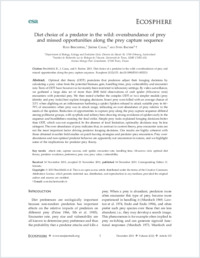Diet choice of a predator in the wild: overabundance of prey and missed opportunities along the prey capture sequence
- Brechbühl, Rolf Department of Biology, Ecology and Evolution Unit, University of Fribourg, Switzerland
- Casas, Jérôme Institut de Recherche sur la Biologie de l'Insecte, Université de Tours, France
- Bacher, Sven Department of Biology, Ecology and Evolution Unit, University of Fribourg, Switzerland
-
14.12.2011
Published in:
- Ecosphere. - 2011, vol. 2, no. 12, p. art133
attack rate
capture success
crab spider
encounter rate
handling time
Misumena vatia
optimal diet theory
predator avoidance
preference
prey size
prey value
vulnerability
English
Optimal diet theory (ODT) postulates that predators adjust their foraging decisions by calculating a prey value from the potential biomass gain, handling time, prey vulnerability and encounter rate. Tests of ODT have however so far mainly been restricted to laboratory settings. By video surveillance, we gathered a large data set of more than 2000 field observations of crab spider (Misumena vatia) encounters with potential prey. We then tested whether the complex ODT or two simpler models (prey identity and prey traits) best explain foraging decisions. Insect prey were killed with an average chance of 3.5% when alighting on an inflorescence harboring a spider. Spiders refused to attack suitable prey in 46–79% of encounters when prey was in attack range, indicating an over-abundance of prey relative to the needs of the spiders. Reduction of opportunities to capture prey along the prey capture sequence differed among pollinator groups, with syrphids and solitary bees showing strong avoidance of spiders early in the sequence and bumblebees resisting the final strike. Simple prey traits explained foraging decisions better than ODT, which was not supported. In the absence of food limitation, optimality decisions may be less stringent. The over-abundance of prey indicates that, in contrast to current theory, prey encounter rates are not the most important factor driving predator foraging decisions. Our results are highly coherent with those obtained in earlier field studies on patch leaving strategies and predator-prey encounters. Prey over-abundance and non-optimal predator behavior are apparently not uncommon in nature, and we highlight some of the implications for predator-prey theory.
- Faculty
- Faculté des sciences et de médecine
- Department
- Département de Biologie
- Language
-
- English
- Classification
- Ecology and biodeversity
- License
-
License undefined
- Identifiers
-
- RERO DOC 28654
- DOI 10.1890/ES11-00323.1
- Persistent URL
- https://folia.unifr.ch/unifr/documents/302381
Statistics
Document views: 134
File downloads:
- pdf: 235
